Wine and Beverage Management: A Comparative Study of Burgundy and Adelaide Hills
VerifiedAdded on 2023/06/09
|9
|2083
|333
AI Summary
This paper explores the wine regions of Burgundy and Adelaide Hills with a comparative study of their history, wine styles, and legislative requirements for wine production. It provides an overview of the regions, their grape varieties, and the different styles of wines produced. The paper also discusses the legislative requirements related to wine production for both regions. Subject: Wine and Beverage Management, Course Code: N/A, Course Name: N/A, College/University: N/A
Contribute Materials
Your contribution can guide someone’s learning journey. Share your
documents today.
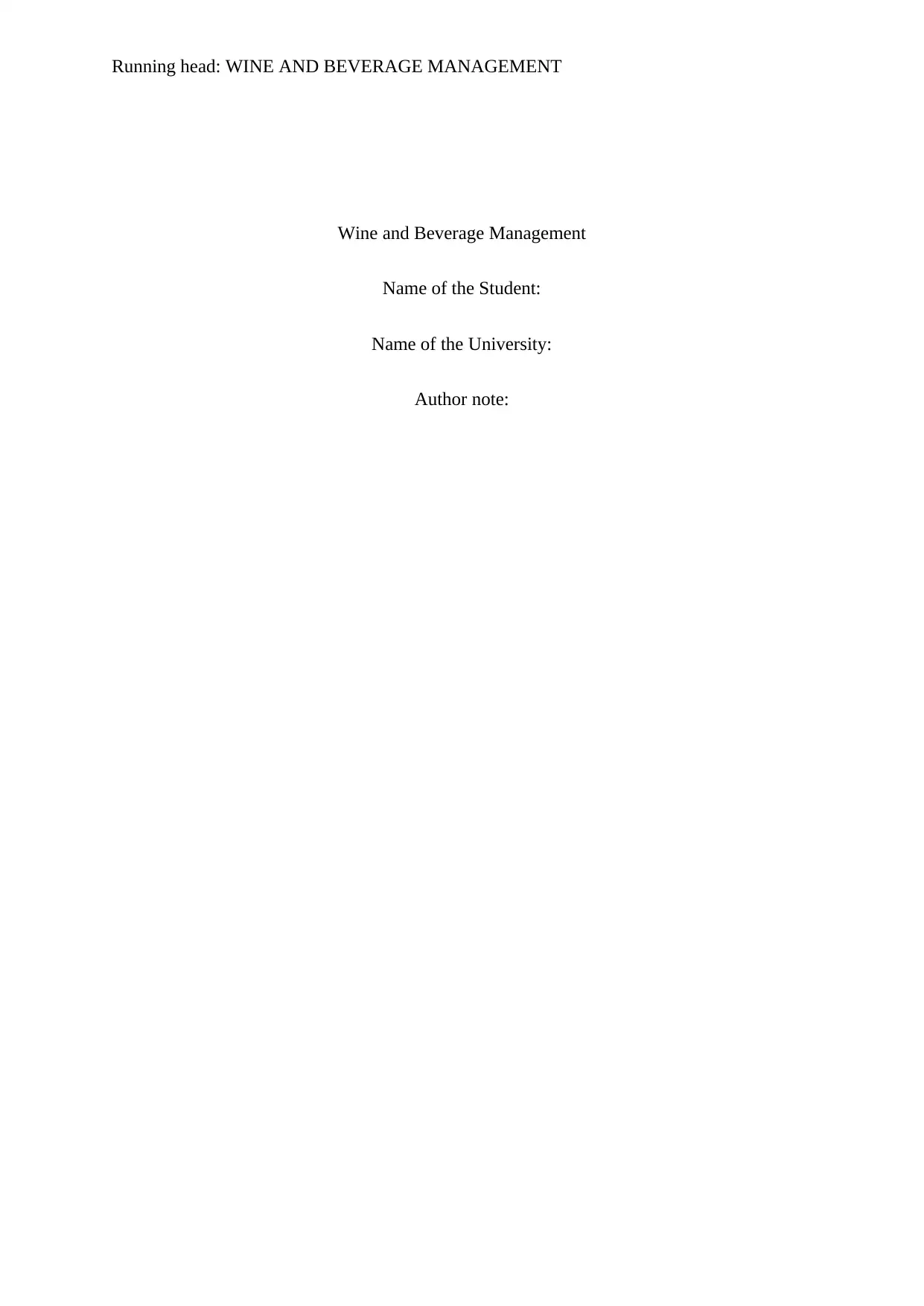
Running head: WINE AND BEVERAGE MANAGEMENT
Wine and Beverage Management
Name of the Student:
Name of the University:
Author note:
Wine and Beverage Management
Name of the Student:
Name of the University:
Author note:
Secure Best Marks with AI Grader
Need help grading? Try our AI Grader for instant feedback on your assignments.
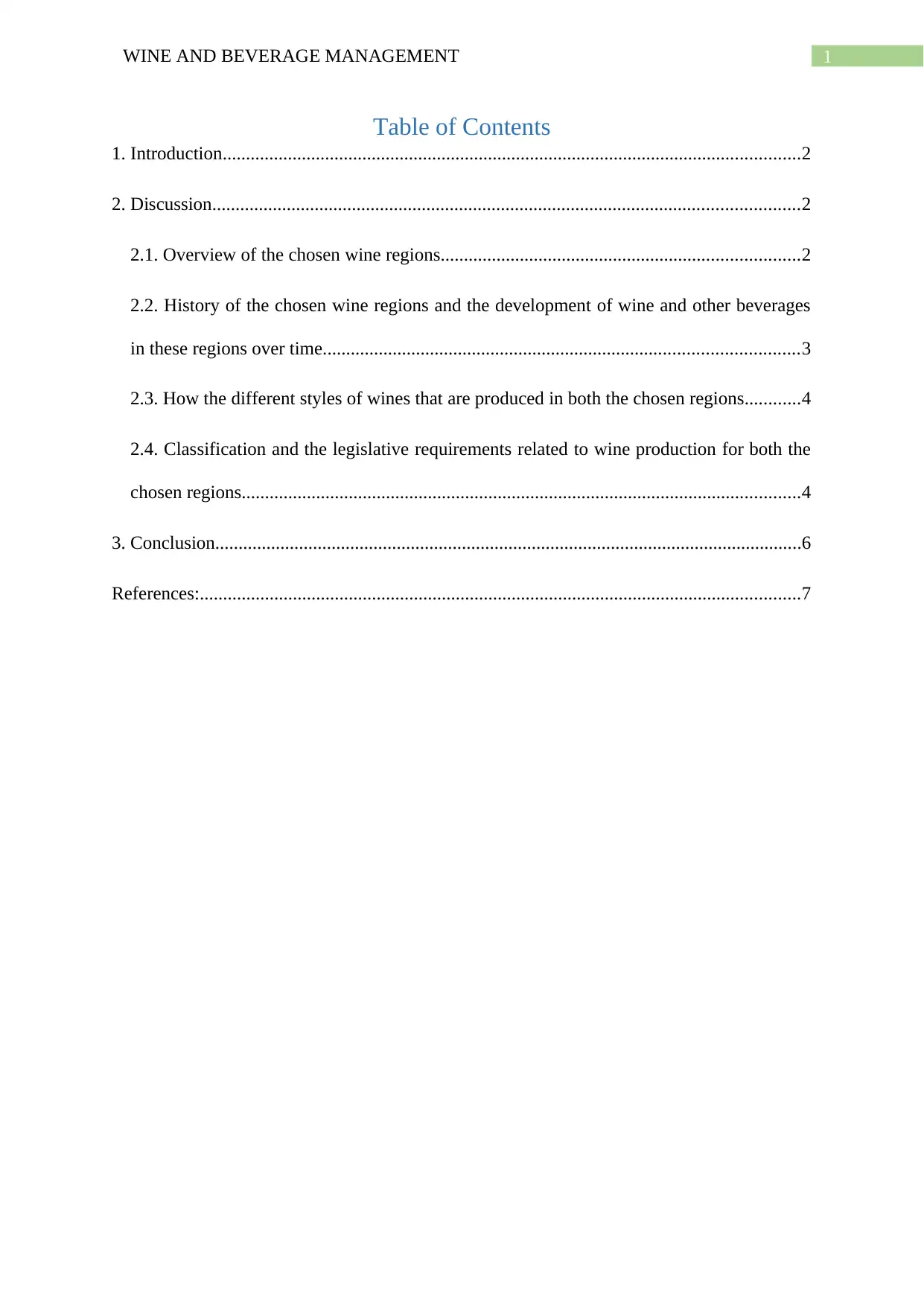
1WINE AND BEVERAGE MANAGEMENT
Table of Contents
1. Introduction............................................................................................................................2
2. Discussion..............................................................................................................................2
2.1. Overview of the chosen wine regions.............................................................................2
2.2. History of the chosen wine regions and the development of wine and other beverages
in these regions over time......................................................................................................3
2.3. How the different styles of wines that are produced in both the chosen regions............4
2.4. Classification and the legislative requirements related to wine production for both the
chosen regions........................................................................................................................4
3. Conclusion..............................................................................................................................6
References:.................................................................................................................................7
Table of Contents
1. Introduction............................................................................................................................2
2. Discussion..............................................................................................................................2
2.1. Overview of the chosen wine regions.............................................................................2
2.2. History of the chosen wine regions and the development of wine and other beverages
in these regions over time......................................................................................................3
2.3. How the different styles of wines that are produced in both the chosen regions............4
2.4. Classification and the legislative requirements related to wine production for both the
chosen regions........................................................................................................................4
3. Conclusion..............................................................................................................................6
References:.................................................................................................................................7
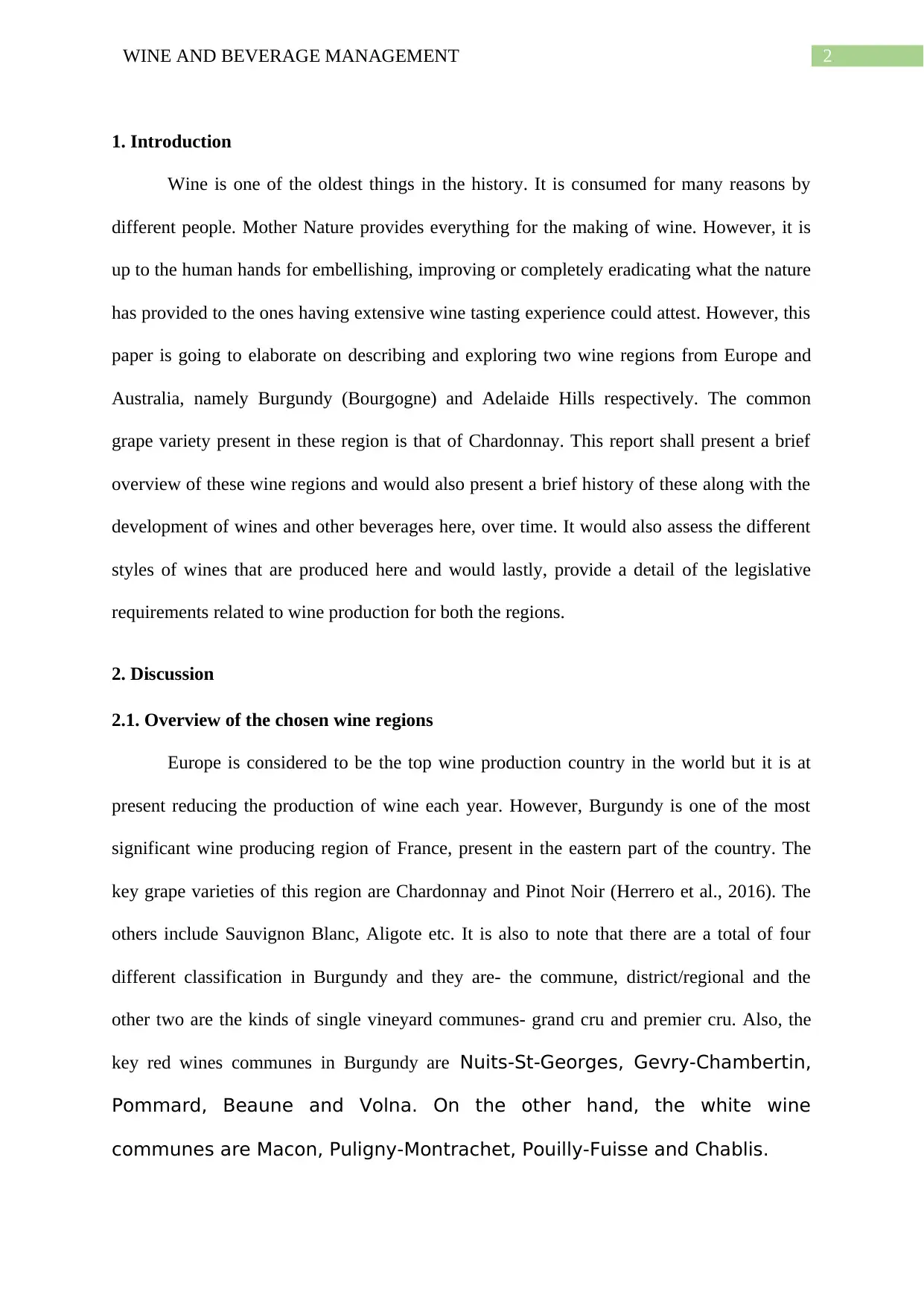
2WINE AND BEVERAGE MANAGEMENT
1. Introduction
Wine is one of the oldest things in the history. It is consumed for many reasons by
different people. Mother Nature provides everything for the making of wine. However, it is
up to the human hands for embellishing, improving or completely eradicating what the nature
has provided to the ones having extensive wine tasting experience could attest. However, this
paper is going to elaborate on describing and exploring two wine regions from Europe and
Australia, namely Burgundy (Bourgogne) and Adelaide Hills respectively. The common
grape variety present in these region is that of Chardonnay. This report shall present a brief
overview of these wine regions and would also present a brief history of these along with the
development of wines and other beverages here, over time. It would also assess the different
styles of wines that are produced here and would lastly, provide a detail of the legislative
requirements related to wine production for both the regions.
2. Discussion
2.1. Overview of the chosen wine regions
Europe is considered to be the top wine production country in the world but it is at
present reducing the production of wine each year. However, Burgundy is one of the most
significant wine producing region of France, present in the eastern part of the country. The
key grape varieties of this region are Chardonnay and Pinot Noir (Herrero et al., 2016). The
others include Sauvignon Blanc, Aligote etc. It is also to note that there are a total of four
different classification in Burgundy and they are- the commune, district/regional and the
other two are the kinds of single vineyard communes- grand cru and premier cru. Also, the
key red wines communes in Burgundy are Nuits-St-Georges, Gevry-Chambertin,
Pommard, Beaune and Volna. On the other hand, the white wine
communes are Macon, Puligny-Montrachet, Pouilly-Fuisse and Chablis.
1. Introduction
Wine is one of the oldest things in the history. It is consumed for many reasons by
different people. Mother Nature provides everything for the making of wine. However, it is
up to the human hands for embellishing, improving or completely eradicating what the nature
has provided to the ones having extensive wine tasting experience could attest. However, this
paper is going to elaborate on describing and exploring two wine regions from Europe and
Australia, namely Burgundy (Bourgogne) and Adelaide Hills respectively. The common
grape variety present in these region is that of Chardonnay. This report shall present a brief
overview of these wine regions and would also present a brief history of these along with the
development of wines and other beverages here, over time. It would also assess the different
styles of wines that are produced here and would lastly, provide a detail of the legislative
requirements related to wine production for both the regions.
2. Discussion
2.1. Overview of the chosen wine regions
Europe is considered to be the top wine production country in the world but it is at
present reducing the production of wine each year. However, Burgundy is one of the most
significant wine producing region of France, present in the eastern part of the country. The
key grape varieties of this region are Chardonnay and Pinot Noir (Herrero et al., 2016). The
others include Sauvignon Blanc, Aligote etc. It is also to note that there are a total of four
different classification in Burgundy and they are- the commune, district/regional and the
other two are the kinds of single vineyard communes- grand cru and premier cru. Also, the
key red wines communes in Burgundy are Nuits-St-Georges, Gevry-Chambertin,
Pommard, Beaune and Volna. On the other hand, the white wine
communes are Macon, Puligny-Montrachet, Pouilly-Fuisse and Chablis.
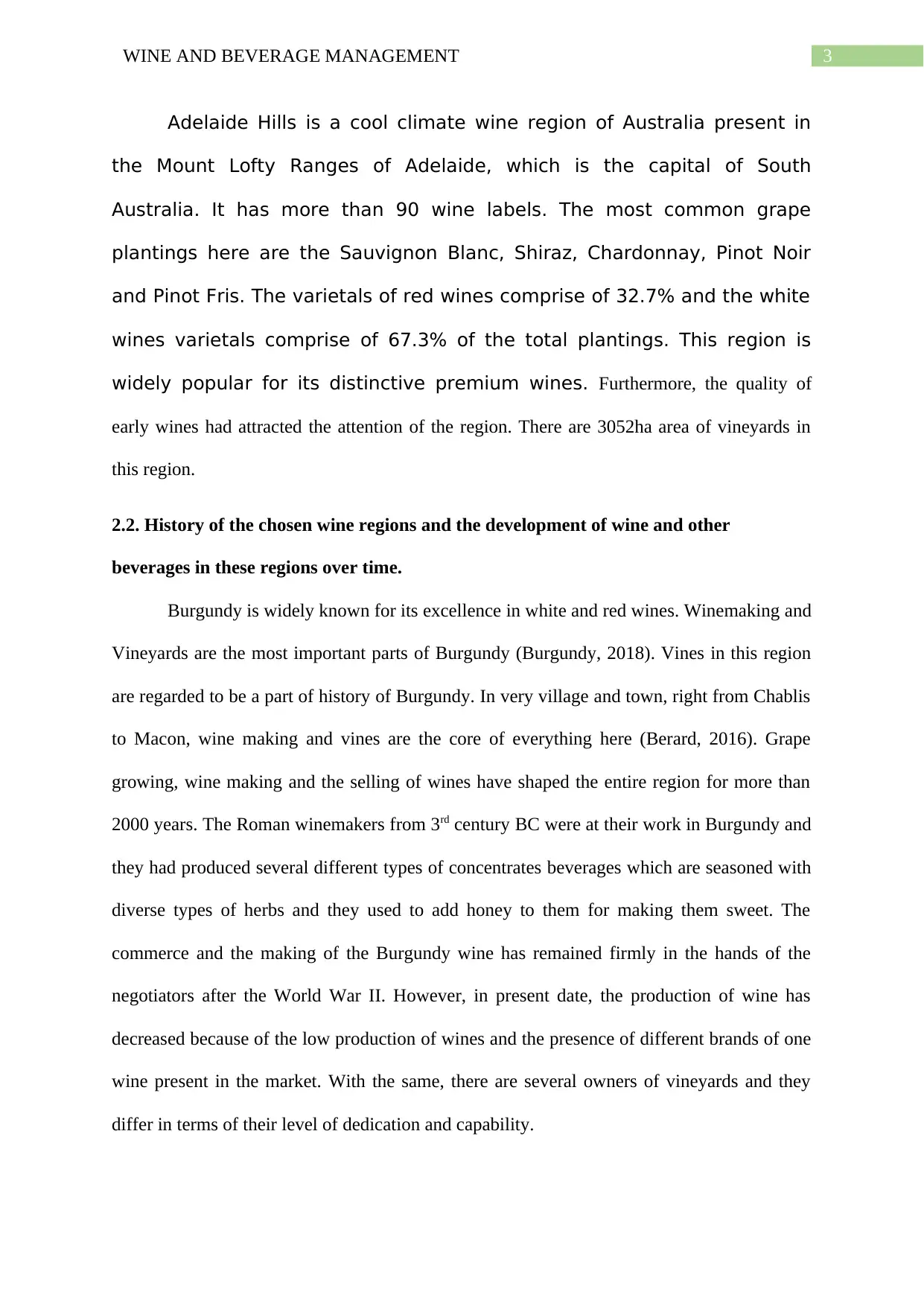
3WINE AND BEVERAGE MANAGEMENT
Adelaide Hills is a cool climate wine region of Australia present in
the Mount Lofty Ranges of Adelaide, which is the capital of South
Australia. It has more than 90 wine labels. The most common grape
plantings here are the Sauvignon Blanc, Shiraz, Chardonnay, Pinot Noir
and Pinot Fris. The varietals of red wines comprise of 32.7% and the white
wines varietals comprise of 67.3% of the total plantings. This region is
widely popular for its distinctive premium wines. Furthermore, the quality of
early wines had attracted the attention of the region. There are 3052ha area of vineyards in
this region.
2.2. History of the chosen wine regions and the development of wine and other
beverages in these regions over time.
Burgundy is widely known for its excellence in white and red wines. Winemaking and
Vineyards are the most important parts of Burgundy (Burgundy, 2018). Vines in this region
are regarded to be a part of history of Burgundy. In very village and town, right from Chablis
to Macon, wine making and vines are the core of everything here (Berard, 2016). Grape
growing, wine making and the selling of wines have shaped the entire region for more than
2000 years. The Roman winemakers from 3rd century BC were at their work in Burgundy and
they had produced several different types of concentrates beverages which are seasoned with
diverse types of herbs and they used to add honey to them for making them sweet. The
commerce and the making of the Burgundy wine has remained firmly in the hands of the
negotiators after the World War II. However, in present date, the production of wine has
decreased because of the low production of wines and the presence of different brands of one
wine present in the market. With the same, there are several owners of vineyards and they
differ in terms of their level of dedication and capability.
Adelaide Hills is a cool climate wine region of Australia present in
the Mount Lofty Ranges of Adelaide, which is the capital of South
Australia. It has more than 90 wine labels. The most common grape
plantings here are the Sauvignon Blanc, Shiraz, Chardonnay, Pinot Noir
and Pinot Fris. The varietals of red wines comprise of 32.7% and the white
wines varietals comprise of 67.3% of the total plantings. This region is
widely popular for its distinctive premium wines. Furthermore, the quality of
early wines had attracted the attention of the region. There are 3052ha area of vineyards in
this region.
2.2. History of the chosen wine regions and the development of wine and other
beverages in these regions over time.
Burgundy is widely known for its excellence in white and red wines. Winemaking and
Vineyards are the most important parts of Burgundy (Burgundy, 2018). Vines in this region
are regarded to be a part of history of Burgundy. In very village and town, right from Chablis
to Macon, wine making and vines are the core of everything here (Berard, 2016). Grape
growing, wine making and the selling of wines have shaped the entire region for more than
2000 years. The Roman winemakers from 3rd century BC were at their work in Burgundy and
they had produced several different types of concentrates beverages which are seasoned with
diverse types of herbs and they used to add honey to them for making them sweet. The
commerce and the making of the Burgundy wine has remained firmly in the hands of the
negotiators after the World War II. However, in present date, the production of wine has
decreased because of the low production of wines and the presence of different brands of one
wine present in the market. With the same, there are several owners of vineyards and they
differ in terms of their level of dedication and capability.
Secure Best Marks with AI Grader
Need help grading? Try our AI Grader for instant feedback on your assignments.
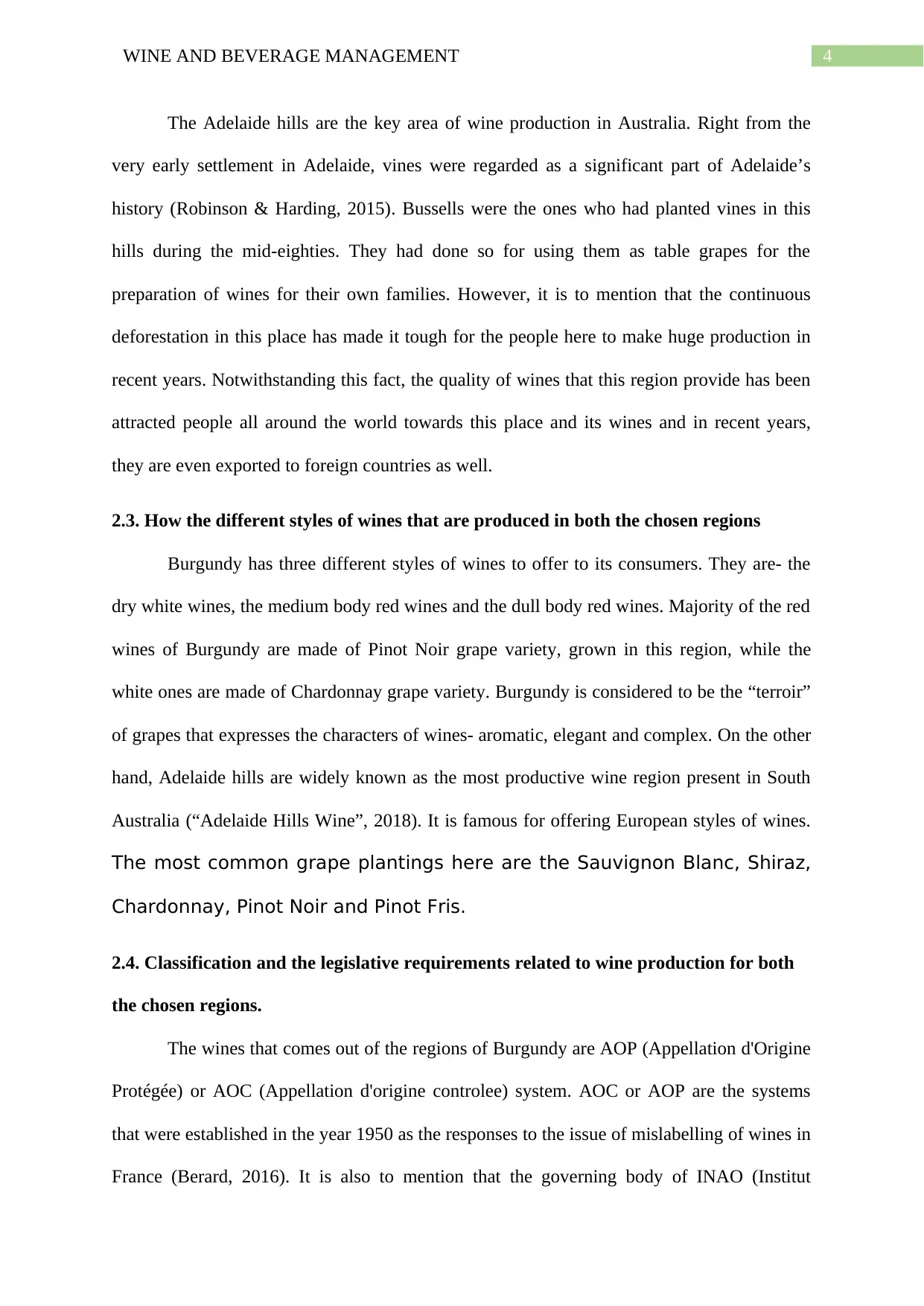
4WINE AND BEVERAGE MANAGEMENT
The Adelaide hills are the key area of wine production in Australia. Right from the
very early settlement in Adelaide, vines were regarded as a significant part of Adelaide’s
history (Robinson & Harding, 2015). Bussells were the ones who had planted vines in this
hills during the mid-eighties. They had done so for using them as table grapes for the
preparation of wines for their own families. However, it is to mention that the continuous
deforestation in this place has made it tough for the people here to make huge production in
recent years. Notwithstanding this fact, the quality of wines that this region provide has been
attracted people all around the world towards this place and its wines and in recent years,
they are even exported to foreign countries as well.
2.3. How the different styles of wines that are produced in both the chosen regions
Burgundy has three different styles of wines to offer to its consumers. They are- the
dry white wines, the medium body red wines and the dull body red wines. Majority of the red
wines of Burgundy are made of Pinot Noir grape variety, grown in this region, while the
white ones are made of Chardonnay grape variety. Burgundy is considered to be the “terroir”
of grapes that expresses the characters of wines- aromatic, elegant and complex. On the other
hand, Adelaide hills are widely known as the most productive wine region present in South
Australia (“Adelaide Hills Wine”, 2018). It is famous for offering European styles of wines.
The most common grape plantings here are the Sauvignon Blanc, Shiraz,
Chardonnay, Pinot Noir and Pinot Fris.
2.4. Classification and the legislative requirements related to wine production for both
the chosen regions.
The wines that comes out of the regions of Burgundy are AOP (Appellation d'Origine
Protégée) or AOC (Appellation d'origine controlee) system. AOC or AOP are the systems
that were established in the year 1950 as the responses to the issue of mislabelling of wines in
France (Berard, 2016). It is also to mention that the governing body of INAO (Institut
The Adelaide hills are the key area of wine production in Australia. Right from the
very early settlement in Adelaide, vines were regarded as a significant part of Adelaide’s
history (Robinson & Harding, 2015). Bussells were the ones who had planted vines in this
hills during the mid-eighties. They had done so for using them as table grapes for the
preparation of wines for their own families. However, it is to mention that the continuous
deforestation in this place has made it tough for the people here to make huge production in
recent years. Notwithstanding this fact, the quality of wines that this region provide has been
attracted people all around the world towards this place and its wines and in recent years,
they are even exported to foreign countries as well.
2.3. How the different styles of wines that are produced in both the chosen regions
Burgundy has three different styles of wines to offer to its consumers. They are- the
dry white wines, the medium body red wines and the dull body red wines. Majority of the red
wines of Burgundy are made of Pinot Noir grape variety, grown in this region, while the
white ones are made of Chardonnay grape variety. Burgundy is considered to be the “terroir”
of grapes that expresses the characters of wines- aromatic, elegant and complex. On the other
hand, Adelaide hills are widely known as the most productive wine region present in South
Australia (“Adelaide Hills Wine”, 2018). It is famous for offering European styles of wines.
The most common grape plantings here are the Sauvignon Blanc, Shiraz,
Chardonnay, Pinot Noir and Pinot Fris.
2.4. Classification and the legislative requirements related to wine production for both
the chosen regions.
The wines that comes out of the regions of Burgundy are AOP (Appellation d'Origine
Protégée) or AOC (Appellation d'origine controlee) system. AOC or AOP are the systems
that were established in the year 1950 as the responses to the issue of mislabelling of wines in
France (Berard, 2016). It is also to mention that the governing body of INAO (Institut
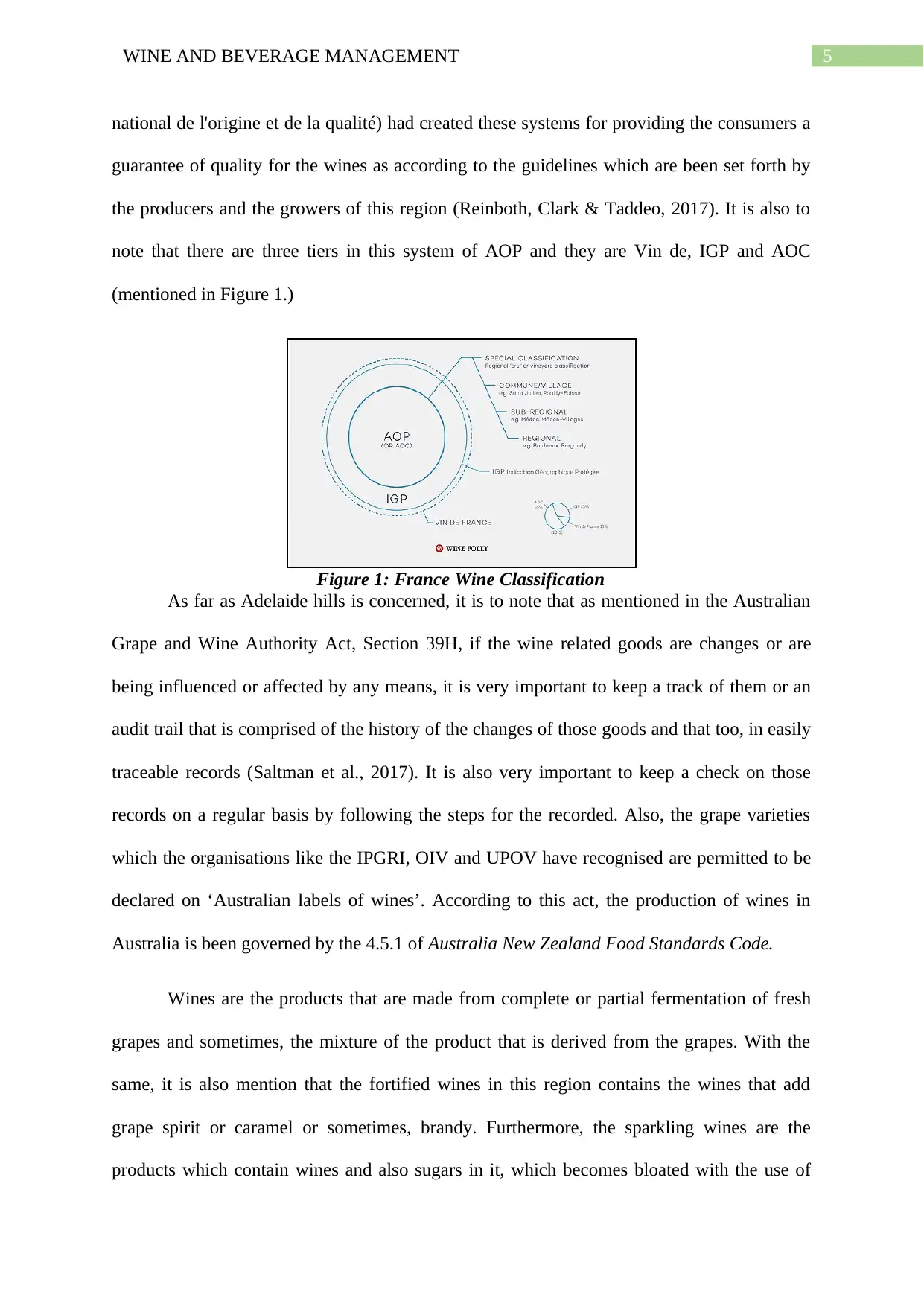
5WINE AND BEVERAGE MANAGEMENT
national de l'origine et de la qualité) had created these systems for providing the consumers a
guarantee of quality for the wines as according to the guidelines which are been set forth by
the producers and the growers of this region (Reinboth, Clark & Taddeo, 2017). It is also to
note that there are three tiers in this system of AOP and they are Vin de, IGP and AOC
(mentioned in Figure 1.)
Figure 1: France Wine Classification
As far as Adelaide hills is concerned, it is to note that as mentioned in the Australian
Grape and Wine Authority Act, Section 39H, if the wine related goods are changes or are
being influenced or affected by any means, it is very important to keep a track of them or an
audit trail that is comprised of the history of the changes of those goods and that too, in easily
traceable records (Saltman et al., 2017). It is also very important to keep a check on those
records on a regular basis by following the steps for the recorded. Also, the grape varieties
which the organisations like the IPGRI, OIV and UPOV have recognised are permitted to be
declared on ‘Australian labels of wines’. According to this act, the production of wines in
Australia is been governed by the 4.5.1 of Australia New Zealand Food Standards Code.
Wines are the products that are made from complete or partial fermentation of fresh
grapes and sometimes, the mixture of the product that is derived from the grapes. With the
same, it is also mention that the fortified wines in this region contains the wines that add
grape spirit or caramel or sometimes, brandy. Furthermore, the sparkling wines are the
products which contain wines and also sugars in it, which becomes bloated with the use of
national de l'origine et de la qualité) had created these systems for providing the consumers a
guarantee of quality for the wines as according to the guidelines which are been set forth by
the producers and the growers of this region (Reinboth, Clark & Taddeo, 2017). It is also to
note that there are three tiers in this system of AOP and they are Vin de, IGP and AOC
(mentioned in Figure 1.)
Figure 1: France Wine Classification
As far as Adelaide hills is concerned, it is to note that as mentioned in the Australian
Grape and Wine Authority Act, Section 39H, if the wine related goods are changes or are
being influenced or affected by any means, it is very important to keep a track of them or an
audit trail that is comprised of the history of the changes of those goods and that too, in easily
traceable records (Saltman et al., 2017). It is also very important to keep a check on those
records on a regular basis by following the steps for the recorded. Also, the grape varieties
which the organisations like the IPGRI, OIV and UPOV have recognised are permitted to be
declared on ‘Australian labels of wines’. According to this act, the production of wines in
Australia is been governed by the 4.5.1 of Australia New Zealand Food Standards Code.
Wines are the products that are made from complete or partial fermentation of fresh
grapes and sometimes, the mixture of the product that is derived from the grapes. With the
same, it is also mention that the fortified wines in this region contains the wines that add
grape spirit or caramel or sometimes, brandy. Furthermore, the sparkling wines are the
products which contain wines and also sugars in it, which becomes bloated with the use of
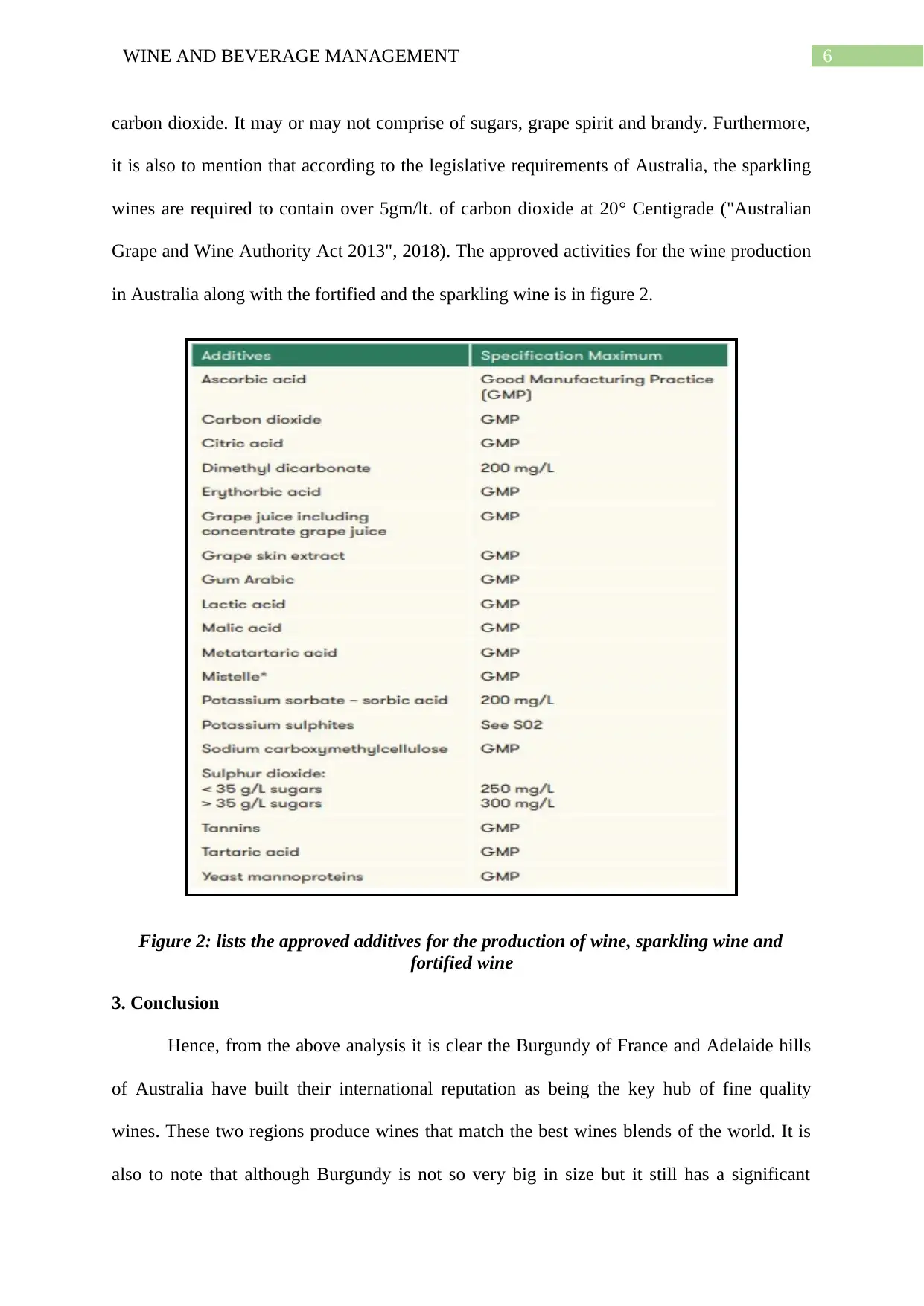
6WINE AND BEVERAGE MANAGEMENT
carbon dioxide. It may or may not comprise of sugars, grape spirit and brandy. Furthermore,
it is also to mention that according to the legislative requirements of Australia, the sparkling
wines are required to contain over 5gm/lt. of carbon dioxide at 20° Centigrade ("Australian
Grape and Wine Authority Act 2013", 2018). The approved activities for the wine production
in Australia along with the fortified and the sparkling wine is in figure 2.
Figure 2: lists the approved additives for the production of wine, sparkling wine and
fortified wine
3. Conclusion
Hence, from the above analysis it is clear the Burgundy of France and Adelaide hills
of Australia have built their international reputation as being the key hub of fine quality
wines. These two regions produce wines that match the best wines blends of the world. It is
also to note that although Burgundy is not so very big in size but it still has a significant
carbon dioxide. It may or may not comprise of sugars, grape spirit and brandy. Furthermore,
it is also to mention that according to the legislative requirements of Australia, the sparkling
wines are required to contain over 5gm/lt. of carbon dioxide at 20° Centigrade ("Australian
Grape and Wine Authority Act 2013", 2018). The approved activities for the wine production
in Australia along with the fortified and the sparkling wine is in figure 2.
Figure 2: lists the approved additives for the production of wine, sparkling wine and
fortified wine
3. Conclusion
Hence, from the above analysis it is clear the Burgundy of France and Adelaide hills
of Australia have built their international reputation as being the key hub of fine quality
wines. These two regions produce wines that match the best wines blends of the world. It is
also to note that although Burgundy is not so very big in size but it still has a significant
Paraphrase This Document
Need a fresh take? Get an instant paraphrase of this document with our AI Paraphraser
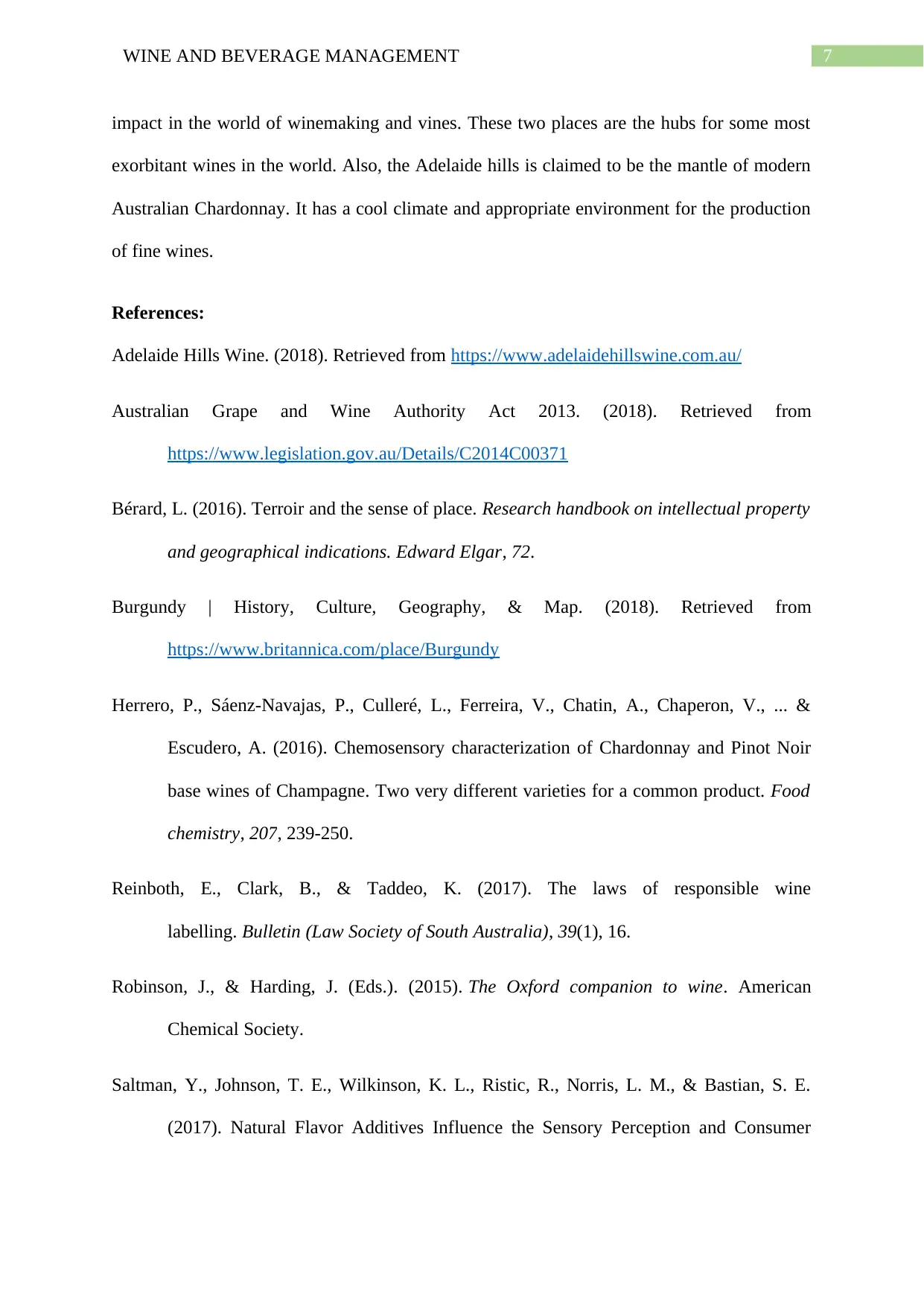
7WINE AND BEVERAGE MANAGEMENT
impact in the world of winemaking and vines. These two places are the hubs for some most
exorbitant wines in the world. Also, the Adelaide hills is claimed to be the mantle of modern
Australian Chardonnay. It has a cool climate and appropriate environment for the production
of fine wines.
References:
Adelaide Hills Wine. (2018). Retrieved from https://www.adelaidehillswine.com.au/
Australian Grape and Wine Authority Act 2013. (2018). Retrieved from
https://www.legislation.gov.au/Details/C2014C00371
Bérard, L. (2016). Terroir and the sense of place. Research handbook on intellectual property
and geographical indications. Edward Elgar, 72.
Burgundy | History, Culture, Geography, & Map. (2018). Retrieved from
https://www.britannica.com/place/Burgundy
Herrero, P., Sáenz-Navajas, P., Culleré, L., Ferreira, V., Chatin, A., Chaperon, V., ... &
Escudero, A. (2016). Chemosensory characterization of Chardonnay and Pinot Noir
base wines of Champagne. Two very different varieties for a common product. Food
chemistry, 207, 239-250.
Reinboth, E., Clark, B., & Taddeo, K. (2017). The laws of responsible wine
labelling. Bulletin (Law Society of South Australia), 39(1), 16.
Robinson, J., & Harding, J. (Eds.). (2015). The Oxford companion to wine. American
Chemical Society.
Saltman, Y., Johnson, T. E., Wilkinson, K. L., Ristic, R., Norris, L. M., & Bastian, S. E.
(2017). Natural Flavor Additives Influence the Sensory Perception and Consumer
impact in the world of winemaking and vines. These two places are the hubs for some most
exorbitant wines in the world. Also, the Adelaide hills is claimed to be the mantle of modern
Australian Chardonnay. It has a cool climate and appropriate environment for the production
of fine wines.
References:
Adelaide Hills Wine. (2018). Retrieved from https://www.adelaidehillswine.com.au/
Australian Grape and Wine Authority Act 2013. (2018). Retrieved from
https://www.legislation.gov.au/Details/C2014C00371
Bérard, L. (2016). Terroir and the sense of place. Research handbook on intellectual property
and geographical indications. Edward Elgar, 72.
Burgundy | History, Culture, Geography, & Map. (2018). Retrieved from
https://www.britannica.com/place/Burgundy
Herrero, P., Sáenz-Navajas, P., Culleré, L., Ferreira, V., Chatin, A., Chaperon, V., ... &
Escudero, A. (2016). Chemosensory characterization of Chardonnay and Pinot Noir
base wines of Champagne. Two very different varieties for a common product. Food
chemistry, 207, 239-250.
Reinboth, E., Clark, B., & Taddeo, K. (2017). The laws of responsible wine
labelling. Bulletin (Law Society of South Australia), 39(1), 16.
Robinson, J., & Harding, J. (Eds.). (2015). The Oxford companion to wine. American
Chemical Society.
Saltman, Y., Johnson, T. E., Wilkinson, K. L., Ristic, R., Norris, L. M., & Bastian, S. E.
(2017). Natural Flavor Additives Influence the Sensory Perception and Consumer
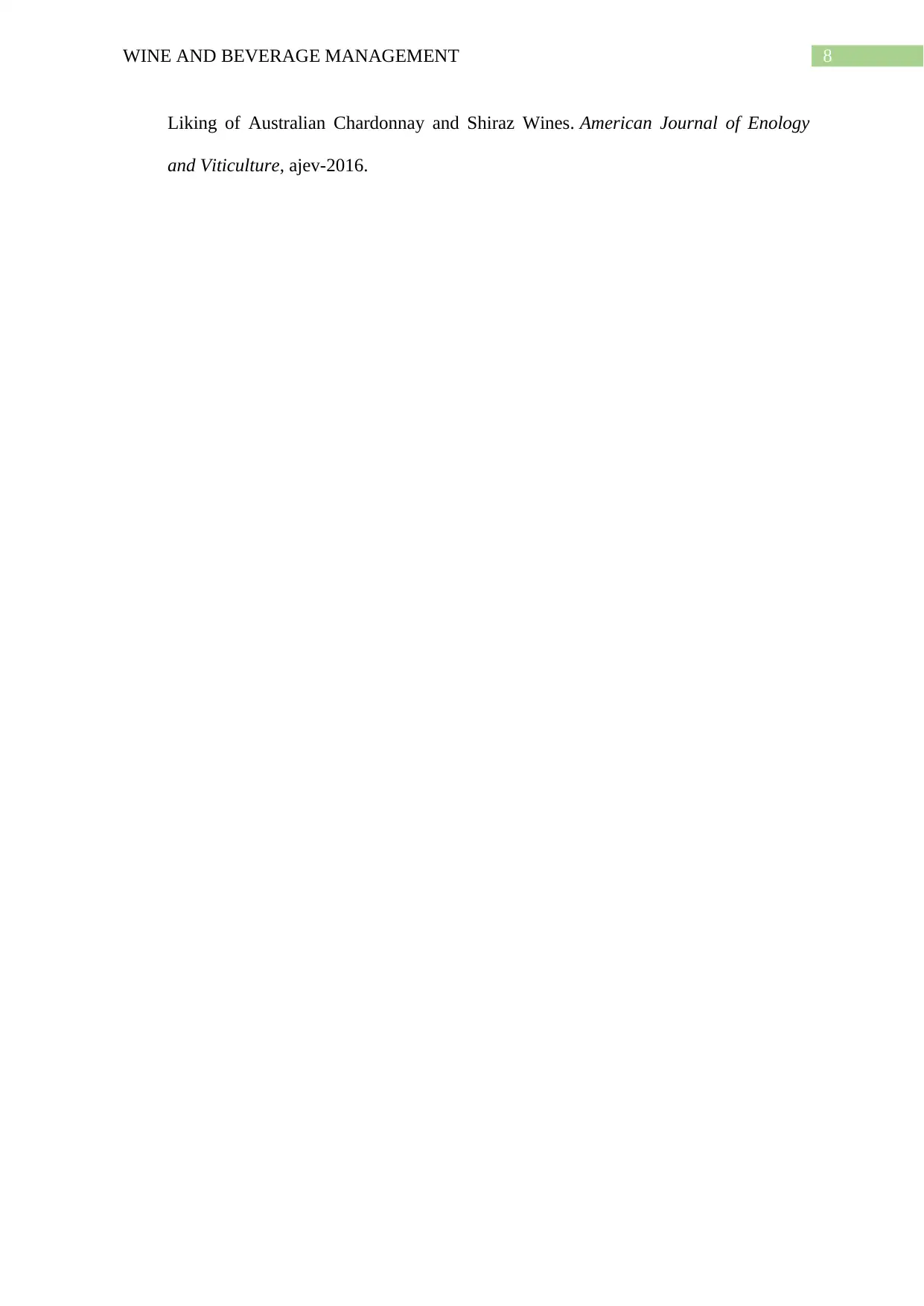
8WINE AND BEVERAGE MANAGEMENT
Liking of Australian Chardonnay and Shiraz Wines. American Journal of Enology
and Viticulture, ajev-2016.
Liking of Australian Chardonnay and Shiraz Wines. American Journal of Enology
and Viticulture, ajev-2016.
1 out of 9
Your All-in-One AI-Powered Toolkit for Academic Success.
+13062052269
info@desklib.com
Available 24*7 on WhatsApp / Email
![[object Object]](/_next/static/media/star-bottom.7253800d.svg)
Unlock your academic potential
© 2024 | Zucol Services PVT LTD | All rights reserved.



